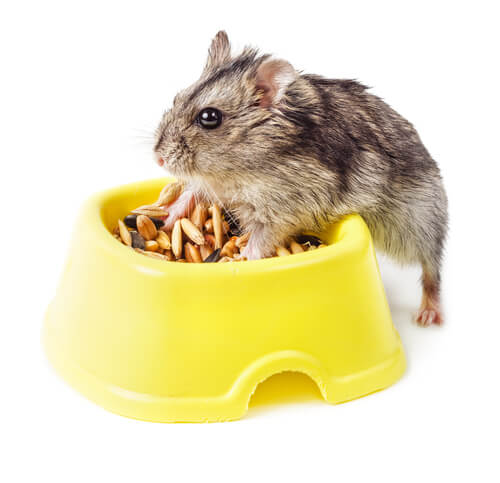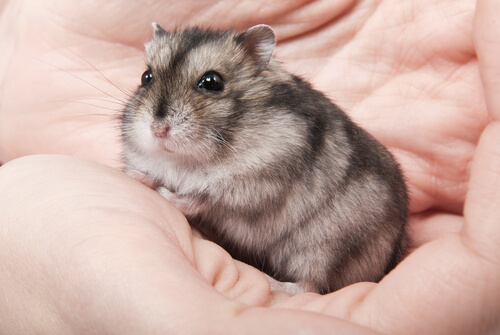How Hamsters Communicate with People


Written and verified by the lawyer Francisco María García
Hamsters are ideal pets for homes without a lot of space. They’re also ideal for owners who want a pet to keep them company, but can’t devote too much time to them. To keep these small animals happy, you need to know how hamsters communicate with their owners.
Hamsters have an average lifespan of two to four years. They don’t need as much care as a dog or cat; taking them out of their cage and exercising them for five minutes will be enough.
Because of how small they are, hamsters don’t require too much food and experts recommend you only give them exactly what they need. These small rodents tend to be stockpilers, so it’s essential to understand the signs in hamster communication.
Calming the hamster with treats
The best way to train a hamster is to raise one from a young age. In this way, you can reward the small animal with treats while calming it down and understanding its behavior.
Proper hamster nutrition consists of salts, minerals, a diet high in fiber, low in fat, and with plenty of vitamins, all necessary for the rodent to have a long life.
These properties can be obtained in cereals and seeds, with the necessary fiber in its diet. In the case of the vitamins necessary for them to be full of energy, fruits and vegetables are recommended.

All these foods should be provided in small quantities and with caution. If food remains in the cage and spoils, it can cause damage to the hamster. For this reason, dry foods sold in pet stores are highly recommended, as they take much longer to spoil.
What is strictly forbidden in a hamster’s diet are salt, chocolate, fats, and sweets in general. Also, to ensure their safety, coriander, wet vegetables, parsley, grapes, carrots, beets, and frozen vegetables should be avoided.
Hamsters communicate through confidence
There’s another way to persuade the hamster, in addition to treats. With your voice and your hands, you can show the rodent that it can trust you.
People with enough free time are recommended to take their little friend in their hands, without squeezing it too tightly, but with enough force so that it doesn’t escape. The next thing to do is to observe what the hamster does.
Another way you can communicate with a rodent is to make unique sounds with it, or to talk to it from a distance. In this way, the small rodent will start wanting us to take it in our hands or to be pampered with a treat.
Hamsters communicate through body language
In addition to these patterns we have seen, we can also understand other elements of the hamster’s body language; we’ll now learn to observe its movements throughout the day.

Stretching or wiping its body slowly means that your little friend is happy and relaxed. However, if it cleans itself compulsively, curls up, or lies on its back, it’s because it feels a threat and fear.
In small hamsters, their way of facing fear and the feeling of threat is by striding around with its tail erect or folding its small ears.
If the hamster hops, digs, and carries things, it means that it’s in a good mood. If the hamster is carrying a lot of material to its nest, it may be preparing to have its young and this is a time to leave it alone.
When the hamster becomes flighty, it may just be tired and it’s time to let it rest in its cage. When it yawns or is irritable it’s also advisable to let them rest.
Hamster communication through sounds
Another way a hamster can communicate with its owner is by the sounds it makes. When a hamster snorts, squeaks, or gnashes its teeth it means it feels threatened.
Squawking, purring, and growling are communicating aggression and a need for space and quiet. In addition, some females make soft beeps to call their young to eat, or to stay close to her.
Keep in mind that hamsters are very territorial and love to rub their bellies against anything they want to mark as theirs. They’re also nocturnal animals, so too much light isn’t good for them.
Hamsters are ideal pets for homes without a lot of space. They’re also ideal for owners who want a pet to keep them company, but can’t devote too much time to them. To keep these small animals happy, you need to know how hamsters communicate with their owners.
Hamsters have an average lifespan of two to four years. They don’t need as much care as a dog or cat; taking them out of their cage and exercising them for five minutes will be enough.
Because of how small they are, hamsters don’t require too much food and experts recommend you only give them exactly what they need. These small rodents tend to be stockpilers, so it’s essential to understand the signs in hamster communication.
Calming the hamster with treats
The best way to train a hamster is to raise one from a young age. In this way, you can reward the small animal with treats while calming it down and understanding its behavior.
Proper hamster nutrition consists of salts, minerals, a diet high in fiber, low in fat, and with plenty of vitamins, all necessary for the rodent to have a long life.
These properties can be obtained in cereals and seeds, with the necessary fiber in its diet. In the case of the vitamins necessary for them to be full of energy, fruits and vegetables are recommended.

All these foods should be provided in small quantities and with caution. If food remains in the cage and spoils, it can cause damage to the hamster. For this reason, dry foods sold in pet stores are highly recommended, as they take much longer to spoil.
What is strictly forbidden in a hamster’s diet are salt, chocolate, fats, and sweets in general. Also, to ensure their safety, coriander, wet vegetables, parsley, grapes, carrots, beets, and frozen vegetables should be avoided.
Hamsters communicate through confidence
There’s another way to persuade the hamster, in addition to treats. With your voice and your hands, you can show the rodent that it can trust you.
People with enough free time are recommended to take their little friend in their hands, without squeezing it too tightly, but with enough force so that it doesn’t escape. The next thing to do is to observe what the hamster does.
Another way you can communicate with a rodent is to make unique sounds with it, or to talk to it from a distance. In this way, the small rodent will start wanting us to take it in our hands or to be pampered with a treat.
Hamsters communicate through body language
In addition to these patterns we have seen, we can also understand other elements of the hamster’s body language; we’ll now learn to observe its movements throughout the day.

Stretching or wiping its body slowly means that your little friend is happy and relaxed. However, if it cleans itself compulsively, curls up, or lies on its back, it’s because it feels a threat and fear.
In small hamsters, their way of facing fear and the feeling of threat is by striding around with its tail erect or folding its small ears.
If the hamster hops, digs, and carries things, it means that it’s in a good mood. If the hamster is carrying a lot of material to its nest, it may be preparing to have its young and this is a time to leave it alone.
When the hamster becomes flighty, it may just be tired and it’s time to let it rest in its cage. When it yawns or is irritable it’s also advisable to let them rest.
Hamster communication through sounds
Another way a hamster can communicate with its owner is by the sounds it makes. When a hamster snorts, squeaks, or gnashes its teeth it means it feels threatened.
Squawking, purring, and growling are communicating aggression and a need for space and quiet. In addition, some females make soft beeps to call their young to eat, or to stay close to her.
Keep in mind that hamsters are very territorial and love to rub their bellies against anything they want to mark as theirs. They’re also nocturnal animals, so too much light isn’t good for them.
All cited sources were thoroughly reviewed by our team to ensure their quality, reliability, currency, and validity. The bibliography of this article was considered reliable and of academic or scientific accuracy.
- Hugues, B., Navaroli, F. & Torres, M. (2011). Roedores como mascotas. Hámster. Revista Cubana de Ciencias Veterinarias, 32 (1), 21-25.
This text is provided for informational purposes only and does not replace consultation with a professional. If in doubt, consult your specialist.








